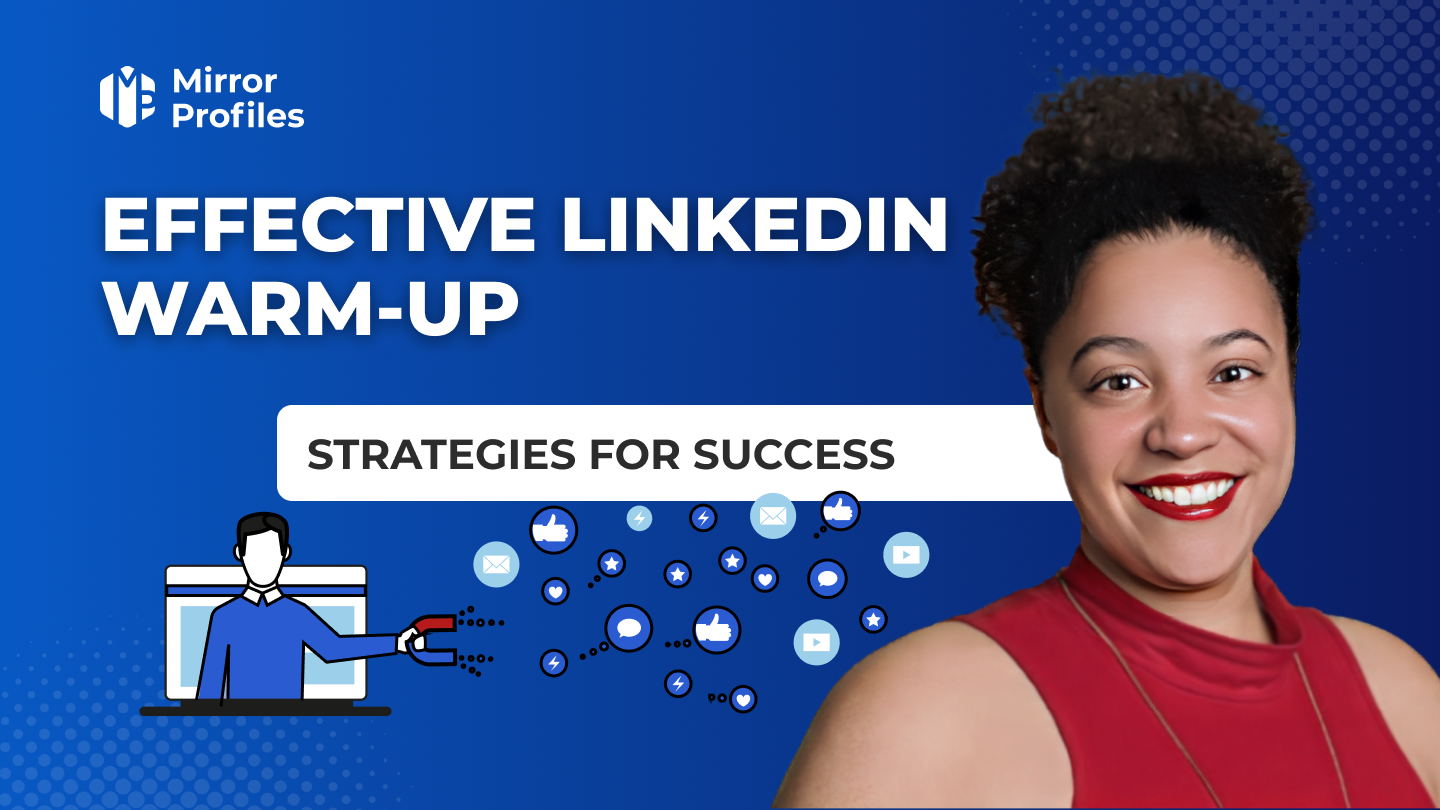Introduction
In the competitive field of B2B marketing, LinkedIn has established itself as an essential platform for outbound campaigns, offering direct access to millions of professionals and key decision-makers worldwide. To navigate Linkedin effectively and turn connections into conversions, it’s essential to master the art and science of outbound campaigns on this platform. This implies an in-depth understanding of the Key Performance Indicators that govern the success of these marketing actions, as well as the integration of innovative marketing tools capable of amplifying the impact of each action undertaken.
This article takes a look at the Key Performance Indicators that are essential for optimizing your prospecting on LinkedIn, exploring their importance, their measurement, and the associated optimization marketing strategy. We’ll also discuss how using Mirrorprofiles can revolutionize your approach to outbound campaigns by multiplying your connection and engagement capabilities, while maintaining a personalization and quality of interaction that reflects your brand. Get ready to dive deep into the growth marketing tactics that will transform your LinkedIn presence into a powerful and profitable lead generation machine.
Understanding the KPIs of an outbound campaign on LinkedIn
Key Performance Indicators are essential for reporting on the effectiveness and efficiency of your outbound campaigns on LinkedIn. These indicators enable you to measure the results of your actions, compare them with your initial objectives and adjust your strategy accordingly. The choice of KPIs must be aligned with your specific prospecting objectives to ensure that they provide relevant insights into performance.
What is a KPI?
A KPI, or Key Performance Indicator, is a measurable value that indicates how effectively a company is achieving its key objectives. In the context of outbound prospecting on LinkedIn, Key Performance Indicators can include metrics such as invitation acceptance rate, message response rate, number of leads generated, etc. These indicators are tools that allow you to evaluate and report on the reach of your campaign, the engagement of your audience and the effectiveness of your messages.
The importance of campaign-specific KPIs
Each outbound prospect has its own objectives, whether to increase brand awareness, generate qualified leads or promote a specific product. Key Performance Indicators are selected in line with these objectives. For example, if the main objective is lead generation, the number of e-mails collected and the number of telephone numbers obtained are relevant KPIs. On the other hand, if the aim is to increase engagement, the response rate to LinkedIn messages sent may be a better indicator.
Essential KPIs for an outbound campaign on LinkedIn
Acceptance rate on Linkedin
The acceptance rate is crucial for measuring and reporting the effectiveness of your first contact on LinkedIn. It is calculated by dividing the number of invitations accepted by the total number of invitations sent, multiplied by one hundred. A high rate can signal that your profile and login message resonate well with your target audience. To improve this rate, it’s essential to optimize your LinkedIn profile by taking care with your photo, title and summary so that they clearly reflect your professionalism and added value. Before Linkedin’s last update in January 2024, personalizing your LinkedIn invitations was also key: mention commonalities, shared interests or specific reasons for requesting a connection, to make your approach as relevant and engaging as possible. However, this LinkedIn “note” message that you can put at the start of every LinkedIn connection request is now reserved for Linkedin accounts that have SalesNavigator.
Response rate on LinkedIn
The response rate to LinkedIn messages is a direct indicator of the interest and commitment of your future customers. To maximize this, the key is to personalize your LinkedIn messages. An approach that takes into account the specifics of each prospect, such as his or her industry, professional challenges or recent interests, can considerably increase your chances of receiving a return. It’s also advisable to adopt a value-driven approach, offering useful content, relevant insights or concrete solutions to problems your future customers might encounter. A clear and direct call to action in your messages will also encourage your recipients to engage in conversation.
Number of invitations sent on Linkedin
The number of LinkedIn invitations you send plays a decisive role in expanding your network and achieving your campaign objectives. To increase your chances of acceptance, it’s important to accurately target your ideal audience. Using advanced filters on LinkedIn can help you flag and detect relevant prospects based on criteria such as industry, function, location or even interests. Use a little inbound marketing: engaging with content published by your future customers before sending an invitation can also make it easier to accept, by creating a positive first point of contact.
Collection of emails and phone numbers
Successful outbound prospecting isn’t limited to engagement on LinkedIn; collecting emails and phone numbers is essential to developing more personalized and direct relationships with your prospects. Once a prospect responds to your solicitations, an opportunity arises to deepen this relationship.
If the prospect has included their email address on their page, this can open the door to more personalized exchanges outside the LinkedIn platform. It is important to note that this email is generally personal, so any further communication should be conducted with discretion and respect for confidentiality. To encourage your contacts to share their contact details, it can be effective to offer something in return, such as exclusive content, a free diagnosis, an invitation to a relevant event or the use of a Linkedin Lead Magnet. Make sure you clearly communicate the prospect’s interest in sharing their information, and respect their confidentiality in compliance with current regulations.
Analyze the ROI of an outbound campaign on LinkedIn
Return on Investment (ROI) analysis is crucial for assessing the overall effectiveness and profitability of your outbound campaigns on LinkedIn. ROI lets you measure the benefits generated against the costs invested in the campaign, providing a clear view of the performance and added value of your marketing efforts.
Calculating the ROI of an outbound campaign
To calculate ROI, identify all the costs associated with your campaign. This can include subscriptions to automation tools, the cost of a LinkedIn Premium subscription, time spent by your sales or marketing team, and any other direct investment in the campaign. Next, you need to determine the revenue generated by the leads obtained through this campaign.
The basic formula for calculating ROI is as follows:
Let’s imagine an outbound campaign on LinkedIn in which you’ve invested €2,000, including subscription costs and your team’s time. As a result of this campaign, you’ve managed to conclude contracts that bring in a total income of €10,000.
Applying the ROI formula:
This means that for every euro invested in the campaign, you’ve generated 4 euros in revenue, indicating a profitable campaign.
The importance of ROI
Calculating ROI is essential for several reasons:
- Performance measurement: This enables you to clearly signal the effectiveness of your outbound prospecting, by showing whether the resources invested are translating into real value for the company.
- Decision support: A clear understanding of ROI can guide your future decisions in terms of budget and resource allocation, enabling you to focus your efforts on the most profitable strategies.
- Strategy optimization: By analyzing the ROI of different campaigns, you can identify the elements that work best and those that need adjustment, enabling you to continually refine your approaches to maximize profitability.
In short, calculating and analyzing ROI is essential to signal the success of your outbound campaigns on LinkedIn. They provide you with concrete data to justify your investments and guide your marketing strategy, ensuring that your efforts make a significant contribution to your company’s growth and profitability. Be careful, though, to keep your “acquisition time” in the equation. In fact, there are different types of ROI: short-, medium- and long-term. Some campaigns can be extremely profitable over the very long term, such as lead generation campaigns aimed at large companies.
Using Mirrorprofiles to optimize KPIs
Account rental is an innovative tool designed to improve the performance of outbound campaigns on LinkedIn. By enabling LinkedIn users to maximize their reach and engagement on the platform, Mirrorprofiles offers a unique marketing solution to boost the key KPIs of outbound prospecting on LinkedIn.
Mirrorprofiles lets users manage multiple LinkedIn profiles, increasing their ability to make connections and engage prospects. By using the Linkedin account rental marketing technique, users can expand their network far beyond what would be possible with a single account, resulting in a higher number of connection requests, interactions, and consequently, qualified leads.
Let’s imagine outbound prospecting where the objective is to generate 100 qualified leads in one month. With a single LinkedIn profile, you’re limited to around 100 invitations per week, for a total of 400 invitations per month. Assuming a 20% acceptance rate, this would translate into 80 new connections, so it would be mathematically impossible to achieve 100 qualified leads per month.
By integrating Mirrorprofiles and managing 5 additional profiles, you multiply your invitation capacity by 6 (your original account plus 5 rented accounts), bringing the total number of invitations to 2,400 per month. Even with a 20% acceptance rate, this represents 480 new connections, well above the initial target of 100 leads.
Increase your KPIs with account rental
Using multiple LinkedIn accounts via Mirrorprofiles significantly increases KPIs such as the number of invitations, the acceptance rate, and by extension, the number of leads generated. This LinkedIn marketing strategy not only allows you to expand your network at an accelerated rate, but also to target your audience more effectively by using different LinkedIn profiles for different market segments.
Best practices for optimizing KPIs with Mirrorprofiles
- Strategic segmentation: Use each LinkedIn profile to target a specific market segment, enabling further personalization of messages and increasing response and acceptance rates.
- Consistency and coherence: Make sure that all LinkedIn profiles reflect your brand or message in a coherent way, while adapting them to the particularities of their respective market segment.
- Tracking and analysis: Analyze KPIs such as invitation acceptance rate, response rate, and number of leads generated to adjust your strategies accordingly.
- Qualitative engagement: Despite using multiple LinkedIn accounts, it’s crucial to maintain a high level of personalization in your interactions to effectively convert connections into qualified leads. This requires the creation of personalized prospecting messages, as well as effective message management afterwards.
By integrating Mirrorprofiles into your outbound strategy on LinkedIn, you can not only increase your KPIs, but also improve the overall effectiveness of your campaigns, leading to greater profitability and higher ROI.
Conclusion
Mastering KPIs and integrating innovative marketing tools like Mirrorprofiles are at the heart of successful outbound campaigns on LinkedIn. Understanding and closely monitoring key indicators such as acceptance rate, response rate, number of invitations and collection of emails and phone numbers means that strategies can be adjusted in real time to optimize performance. ROI analysis, meanwhile, provides an essential perspective on the overall effectiveness and profitability of the efforts deployed, guiding future decisions.
The integration of solutions like Mirrorprofiles, with its innovative approach to managing multiple LinkedIn profiles, offers an unprecedented opportunity to extend the reach and impact of outbound campaigns. By multiplying the points of contact with the target audience, this strategy significantly increases the volume of interactions and, consequently, the number of qualified leads generated.
However, it’s crucial to maintain a personalized, high-quality approach to interactions, even when operating on a larger scale. Engagement must remain authentic and bring real added value to prospects to effectively convert connections into sales opportunities. The judicious use of Mirrorprofiles, combined with rigorous KPI tracking and ongoing ROI analysis, is a powerful formula for maximizing the effectiveness of outbound campaigns on LinkedIn.
In short, the key to success lies in a balanced approach that combines the strategic use of data and innovative technologies with personalized, human involvement. By adopting this approach, companies can not only meet, but exceed their campaign objectives and generate qualified leads on LinkedIn with MirrorProfiles, transforming the platform into a powerful lever for lead generation and business growth.







